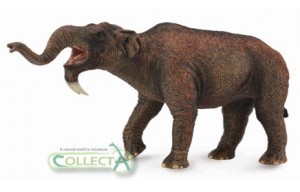The New CollectA Deinotherium Model Fact Sheet Preparations
Making Preparations for the Arrival of the CollectA Deinotherium Model in 2013
With new prehistoric animal models being introduced by a number of replica and figure manufacturers next year, team members at Everything Dinosaur have started to research and write fact sheets to accompany these additions. We are busy preparing notes in readiness for the arrival of the CollectA Deinotherium model.
CollectA Deinotherium Model
One of the first fact sheets to be prepared is one on the extinct elephant Deinotherium (Deinotherium giganteum). CollectA will be making a model of this huge prehistoric mammal, it will be available in the late spring of 2013 and will form part of the company’s “prehistoric life” model series.
The New CollectA Deinotherium Model
Picture credit: Everything Dinosaur
CollectA Deluxe Figures
The CollectA Deinotherium model will be part of the CollectA Deluxe range of models and figures: CollectA Deluxe Scale Prehistoric Animal Models.
We were telephoned the other day by a customer, they requested a Deinotherium fact sheet and we had to explain that at the moment, the fact sheet was still being prepared, however, here is a quick potted history of the Deinotherium genera with a focus on the largest known member – D. giganteum.
Deinotherium was a member of the elephant family, but it is not closely related to modern elephants or Mammoths. It is likely that the ancestors of Deinotherium diverged from other forms of primitive elephant very early in the evolutionary history of the group. It had relatively long legs and a long, low skull, rather than the domed skull of more modern elephants. The front part of the lower jaw was turned downwards and deinotheres possessed two over-sized, tusk-like incisors that curved downwards in a hook-like configuration. The trunk was shorter than those of living elephants.
Deinotherium
It is likely that these prehistoric elephants first evolved in Africa and a number of species of Deinotherium are known, the largest of which lived in Europe. The Deinotherium genus was established in the mid 19th Century, however, many fossils had been found in Early Pliocene aged deposits in western Germany and added to the natural history collection of the Hessian State Museum in the nearby town of Darmstadt. The first species of Deinotherium was scientifically named and described in 1829 by the German naturalist Johann Jakob Kaup. Unfortunately, when Kaup prepared a reconstruction of the complete fossil for a museum exhibit, he first posed the tusks of the lower jaw pointing upwards. With the discovery of a complete skull in 1836, this initial mistake was corrected.
The name Deinotherium means “terrible beasts” and European specimens suggest that some of these prehistoric elephants were amongst the largest land living creatures of the Late Miocene epoch. A fully grown, male Deinotherium giganteum could have weighed as much as fourteen tonnes and been over four metres high at the shoulder. Deinotherium fossils are associated with hominid fossil bearing strata of Africa it is likely that Australopithecines and other early hominids would have been very familiar with these strange, tusked elephants.
The exact purpose of the downward pointing incisors in the lower jaw that formed the tusks remains an area of debate amongst palaeontologists. Some scientists have suggested that these extinct elephants used their tusks to scrape bark from trees whilst others state that the curved tusks could have been used to hook branches and pull them down so that this large herbivore could feed on the leaves. Studies of the teeth of Deinotherium species suggest that these elephants were adapted to living in forests rather than open savannah based environments. The very last deinotheres survived into the early Pleistocene epoch. Fossils have been found in Africa indicating that a species of Deinotherium was around approximately one million years ago. These fossils have been found in western Kenya (Kanjara Formation) and indicate that one species of Deinotherium (D. bozasi) was present in east Africa until relatively recent times.
Prepared for Sandra, Akash, Simon, Ashley, Colin and all the other Deinotherium fans we have encountered recently.


